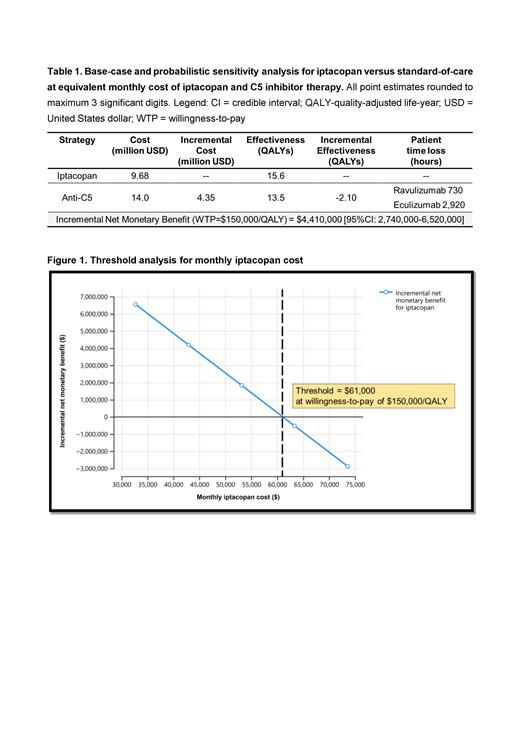Introduction:
Oral complement inhibition therapy has the potential to transform the care of patients with paroxysmal nocturnal hemoglobinuria (PNH), a life-threatening hematological disorder characterized by intravascular hemolysis, thrombosis, and bone marrow failure. Current standard-of-care (SOC) for PNH are monoclonal antibodies targeting the distal complement component 5 (C5) and include the intravenous agents eculizumab and ravulizumab. However, this distal mechanism of action allows extravascular hemolysis to persist. Intravenous therapy also requires patient and nursing time spent for infusion care. Iptacopan is one oral proximal complement pathway inhibitor that selectively inhibits complement factor B. Clinical trial data shows that iptacopan controls both intravascular and extravascular hemolysis, resulting in increased transfusion independence. Iptacopan was granted breakthrough therapy designation for expedited review by the FDA. The potential approval is anticipated by the end of 2023, after which point pricing will be set. A cost-effective price for iptacopan is currently not known. We sought to fill this gap by conducting the first cost-effectiveness analysis of oral versus intravenous complement inhibitor therapy in PNH to determine a cost-effective monthly price threshold for iptacopan monotherapy and to estimate patient and nursing time saved with transition to oral therapy.
Methods:
In this independent analysis free of industry influence, we built a Markov model to first determine the cost-effectiveness of iptacopan monotherapy at a monthly cost equivalent to SOC. Second, we solved for the cost-effective monthly maximum threshold cost of iptacopan across accepted willingness-to-pay thresholds in US dollars per quality-adjusted life-year (QALY). Transition probabilities for transfusion burden and breakthrough hemolysis were informed by the phase III study results (NCT 04558918). Probabilities of transfusion-associated adverse events were sourced from hemovigilance reporting in the 2015 National Blood Collection and Utilization Survey. Costs were assessed in 2023 US dollars and were informed from the Centers for Medicare & Medicaid Services and PNH-specific health resource utilization literature. The latter accounted for country- and PNH-specific direct and indirect medical costs, derived after adjustment for baseline characteristics, and isolated for transfusion-dependent treatment-experienced patients with PNH by comparison to transfusion-independent, treatment-experienced patients with PNH. Effectiveness was calculated in quality-adjusted life-years (QALY), and employed PNH-specific utilities. The two primary outcomes for iptacopan monotherapy were 1) the incremental cost-effectiveness ratio (ICER) or, the incremental net monetary benefit (iNMB) if the therapy was found to be cost saving, and 2) the cost-effective maximum monthly threshold price of iptacopan monotherapy, as compared to the SOC. The secondary outcome was the aggregated patient and nursing time saved with the use of oral versus intravenous treatment. We concluded with deterministic sensitivity analysis to isolate parameters that the model results are most sensitive to, and probabilistic sensitivity analysis to capture uncertainty in all parameters simultaneously over 10,000 Monte Carlo simulations.
Results:
In the base-case (i.e., where monthly price of iptacopan is equivalent to SOC), therapy with iptacopan versus C5 inhibition accrued 15.6 and 13.5 QALYs at costs of $9.7 million and $14.0 million, respectively. The iNMB with iptacopan was $4.4 million (95% credible interval $2.7-6.5 million) and threshold analysis for the maximum monthly price of iptacopan was $61,000. Iptacopan therapy projects to save patients and nurses approximately 730 and 2920 hours for ravulizumab and eculizumab, respectively, in PNH-specific care averted. Model results were most sensitive to iptacopan price.
Conclusion:
If the monthly price is no more than 149% of SOC, iptacopan monotherapy can be a cost-effective therapeutic option for transfusion-dependent, treatment-experienced patients with PNH. This is achieved by increasing the proportion of transfusion-independence in this patient population and, in turn, decreasing the burden of both the risks and costs associated with health resource utilization for patients with PNH.
Disclosures
No relevant conflicts of interest to declare.


This feature is available to Subscribers Only
Sign In or Create an Account Close Modal